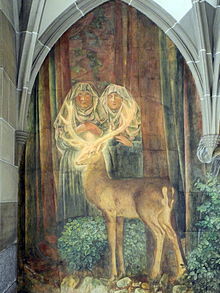This article needs additional citations for
verification. (January 2019) |
Hildegarda | |
|---|---|
 Fresco by Paul Bodmer in the abbey of Fraumünster showing the two daughters of Louis the German | |
| Abbess | |
| Honored in | Catholic Church |
| Major shrine | Fraumünster |
| Feast | 23 December |
Hildegard (828 – December 23 856 or 859) was the daughter of Louis the German, Carolingian king of East Francia, and his wife Hemma. She was the abbess of Fraumünster, an abbey founded by her father.
Hildegard was the eldest child of Louis the German and the countess Hemma, born a year after their marriage.

In 844, she became the abbess of Münsterschwarzach in Bavaria, the Eigenkloster of the Carolingian court, founded in 780. On June 21, 853, Louis the German founded the abbey at Fraumünster, placing his daughter Hildegard as the abbess, while her younger sister Bertha succeeded her as abbess of Münsterschwarzach.
According to legend, the two sisters were living a cloistered life together at Baldern Castle. While travelling to Zürich to pray at the chapel of Saints Felix and Regula, they saw a deer with lighted antlers, who led them through the forest to a location beside the River Limmat. The sisters took this as a sign from God that a church was to be built at that location, and Louis the German obeyed this divine invitation. What is historically certain is that an abbey had been recently founded at Fraumünster, and this abbey with its considerable property and right to autonomous jurisdiction was entrusted to Hildegard.
Hildegard died December 23, 856 (some sources say 859). As before, her sister Bertha succeeded her as abbess of Fraumünster.
Hildegard is honored in the Catholic Church on 23 December. [1] [2] [3] [4]
References
- ^ Helvetia Sancta: Oder Leben Und Wirken Der Heiligen, Seligen Und Frommen Personen Des Schweizerlandes. New York: Karl und Nicholaus Benziger. 1862. ISBN 9785879313277.
- ^ Zeno. "Lexikoneintrag zu »Hildegarda«. Vollständiges Heiligen-Lexikon, Band 2. Augsburg ..." zeno.org (in German). Retrieved 2021-06-12.
- ^ "Zürcher Legenden - Stadt Zürich". stadt-zuerich.ch (in German). Retrieved 2021-06-12.
- ^ Nieke, Erdmute (2008). Religiöse Bilderbogen aus Neuruppin: eine Untersuchung zur Frömmigkeit im 19. Jahrhundert (in German). Peter Lang. ISBN 978-3-631-57156-9.
Further reading
- Gerhard Hartmann, Karl Schnith (Hrsg.), Die Kaiser. 1200 Jahre Europäische Geschichte. Marixverlag, Wiesbaden 2006, ISBN 3-86539-074-9, p. 70. (in German)
- Peter Vogelsanger, Zürich und sein Fraumünster. Eine elfhundertjährige Geschichte (853–1956). NZZ Libro, Zürich 1994, ISBN 3-85823-515-6. (in German)
This article needs additional citations for
verification. (January 2019) |
Hildegarda | |
|---|---|
 Fresco by Paul Bodmer in the abbey of Fraumünster showing the two daughters of Louis the German | |
| Abbess | |
| Honored in | Catholic Church |
| Major shrine | Fraumünster |
| Feast | 23 December |
Hildegard (828 – December 23 856 or 859) was the daughter of Louis the German, Carolingian king of East Francia, and his wife Hemma. She was the abbess of Fraumünster, an abbey founded by her father.
Hildegard was the eldest child of Louis the German and the countess Hemma, born a year after their marriage.

In 844, she became the abbess of Münsterschwarzach in Bavaria, the Eigenkloster of the Carolingian court, founded in 780. On June 21, 853, Louis the German founded the abbey at Fraumünster, placing his daughter Hildegard as the abbess, while her younger sister Bertha succeeded her as abbess of Münsterschwarzach.
According to legend, the two sisters were living a cloistered life together at Baldern Castle. While travelling to Zürich to pray at the chapel of Saints Felix and Regula, they saw a deer with lighted antlers, who led them through the forest to a location beside the River Limmat. The sisters took this as a sign from God that a church was to be built at that location, and Louis the German obeyed this divine invitation. What is historically certain is that an abbey had been recently founded at Fraumünster, and this abbey with its considerable property and right to autonomous jurisdiction was entrusted to Hildegard.
Hildegard died December 23, 856 (some sources say 859). As before, her sister Bertha succeeded her as abbess of Fraumünster.
Hildegard is honored in the Catholic Church on 23 December. [1] [2] [3] [4]
References
- ^ Helvetia Sancta: Oder Leben Und Wirken Der Heiligen, Seligen Und Frommen Personen Des Schweizerlandes. New York: Karl und Nicholaus Benziger. 1862. ISBN 9785879313277.
- ^ Zeno. "Lexikoneintrag zu »Hildegarda«. Vollständiges Heiligen-Lexikon, Band 2. Augsburg ..." zeno.org (in German). Retrieved 2021-06-12.
- ^ "Zürcher Legenden - Stadt Zürich". stadt-zuerich.ch (in German). Retrieved 2021-06-12.
- ^ Nieke, Erdmute (2008). Religiöse Bilderbogen aus Neuruppin: eine Untersuchung zur Frömmigkeit im 19. Jahrhundert (in German). Peter Lang. ISBN 978-3-631-57156-9.
Further reading
- Gerhard Hartmann, Karl Schnith (Hrsg.), Die Kaiser. 1200 Jahre Europäische Geschichte. Marixverlag, Wiesbaden 2006, ISBN 3-86539-074-9, p. 70. (in German)
- Peter Vogelsanger, Zürich und sein Fraumünster. Eine elfhundertjährige Geschichte (853–1956). NZZ Libro, Zürich 1994, ISBN 3-85823-515-6. (in German)